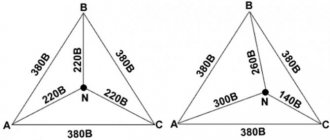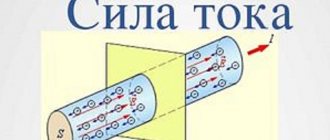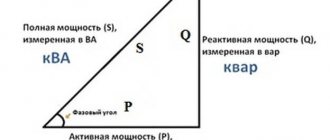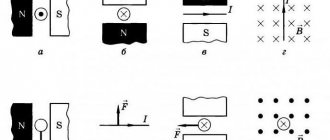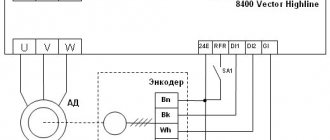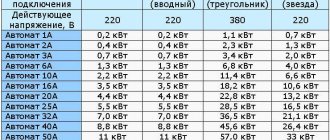Author of the article
Alexander Georgievich Kondratiev
An electrical engineer by training, he worked as an electronics engineer, chief engineer at a food company, and general director of a construction organization.
Knowing the installed power of electrical appliances is important for the correct selection of electrical wiring and protection devices. This is necessary to ensure the safe operation of appliances in the home.
The power of household electrical appliances is measured in watts, and in calculations of high-power electrical networks the concept of kilowatt is used. Therefore, the owner, before making calculations, needs to know what equipment is installed in the house and what power it is. And for design you need to figure out how many watts are in a kilowatt.
What is watt
The unit value of electrical energy for the work done over a period of time is called a watt.
Named after the mechanic and inventor James Watt. Denoted by W or W. He was the first to propose the use of horsepower as a universal unit of measurement of machine performance.
Can be represented by the formula:
W = joule/second, or 1 W = 1 J/sec.
To determine the power of electrical machines, the following formula is used:
P=U*I. Voltage times current.
Electricity is measured by "U" in volts and "I" in amperes by the resulting power in watts.
Power units
2.1 Power units used in the energy sector
- Watt – W – unit of power in the SI system, derivatives – kW, MW, GW
- Calories per hour - cal/h - an off-system unit of power, usually in the energy sector derived values are used - kcal/h, Mcal/h, Gcal/h;
- Tonnes of steam per hour - t/h - a specific value corresponding to the power required to produce steam from 1 ton of water per hour.
2.2. Examples of correct use of power units
- Boiler design power
- Heat losses of the building
- Maximum consumption of thermal energy for heating hot water
- Engine power
- Average daily power of thermal energy consumers
How to convert watts to kilowatts
Household electrical appliances have different power ratings. It ranges from a few watts to several thousand watts. For convenience of calculation, they lead to a single value. This is usually a kilowatt, denoted kW.
To convert watts to kilowatts, you need to know how many watts are contained in 1 kW. The word “kilo” itself means a thousand. That is, one kilowatt of electricity contains 1000 watts.
For the convenience of converting one unit to another, there are various programs. But converting from one value to another is easy to do on your own.
For example, a house has several electricity consumers, a chandelier with three 60 W lamps, a 150 W TV and a 100 W stereo system. We get 3*60+150+100, the result is 430 W. We know that 1KW contains 1000W. Divide this value by 1000, we get 0.43 kW.
For clarity, we will make several calculations. The resulting conversion from W to kW will be tabulated.
| W | 5 | 90 | 100 | 250 | 500 | 750 | 1000 | 2500 | 10500 |
| kW | 0,005 | 0,09 | 0,1 | 0,25 | 0,5 | 0,75 | 1 | 2,5 | 10,5 |
Often it is necessary to perform the inverse function. Convert from kW to Watts. To do this, the power in kilowatts must be multiplied by 1,000. Let’s make calculations and put them in a table for clarity.
| kW | 5 | 2,5 | 1 | 0,85 | 0,4 | 0,25 | 0,08 | 0,007 |
| W | 5 000 | 2500 | 1000 | 850 | 400 | 250 | 80 | 7 |
Industrial enterprises use electricity consumers with a capacity of several thousand kilowatts. For convenience, the concept of megawatt has been introduced, denoted as mW. The prefix “mega” means 1,000,000. That is, 1 mW contains 1,000,000 W, or 1,000 kW.
Energy units
1.1. Units of energy measurement used in the energy sector
- Joule – J – SI unit, and derivatives – kJ, MJ, GJ
- Calorie - cal - non-systemic unit, and derivatives kcal, Mcal, Gcal
- kWh is an off-system unit that is usually (but not always!) used to measure the amount of electricity.
- ton of steam is a specific value that corresponds to the amount of thermal energy required to produce steam from 1 ton of water. It does not have the status of a unit of measurement, however, it is practically used in the energy sector.
Energy units are used to measure the total amount of energy (thermal or electrical). In this case, the value can indicate generated, consumed, transmitted or lost energy (over a certain period of time).
1.2. Examples of correct use of energy units
- Annual demand for thermal energy for heating, ventilation, hot water supply.
- Required amount of thermal energy to heat ... m3 of water from ... to ... °C
- Thermal energy in ... thousand m3 of natural gas (in the form of calorific value).
- Annual demand for electricity to power the boiler room's electrical receivers.
- Annual boiler room steam production program.
1.3. Conversion between energy units
1 GJ = 0.23885 Gcal = 3600 million kWh = 0.4432 t (steam)
1 Gcal = 4.1868 GJ = 15072 million kWh = 1.8555 t (steam)
1 million kWh = 1/3600 GJ = 1/15072 Gcal = 1/8123 t (steam)
1 t (steam) = 2.256 GJ = 0.5389 Gcal = 8123 million kWh
Note: When calculating 1 ton of steam, the enthalpy of the source water and water vapor at the saturation line at t=100 °C was taken
Kilowatt and kilowatt-hour - what's the difference?
Along with the designation kilowatt, you can find the unit kilowatt per hour. For example, electricity meter readings are displayed in kWh values. Non-specialists do not distinguish between these concepts and believe that they are one and the same thing. However, these are completely different quantities.
Watt per hour is the amount of electricity produced or consumed per unit of time, denoted Wh.
For example, 1 kW hour means that the power receiver consumes 1 kW of electricity in 1 hour.
Kilowatt, unlike kWh, is a quantity indicating instantaneous power consumed or generated.
General information
The name of the unit of measurement of electric current power comes from the name of the Scottish engineer-inventor James Watt (1736−1819), who is known throughout the world. He invented the steam engine. Electrical power is measured in watts (W).
Each electrical device has a certain power and consumes a certain amount of electrical energy. Its value is measured in watts, and for powerful consumers - in kilowatts. However, some people do not realize that kilowatt and kilowatt-hour are two different units of measurement. In this case, it is necessary to consider the physical meaning of the basic physical quantities that determine them: current strength, voltage (potential difference), resistance (electrical conductivity), operating time of electrical equipment.
Current strength
Current strength is the amount of electrical charge passing through a conductor per unit time. The value is designated by the letter “I” and measured in amperes. It is found by calculation or measured using an electronic measuring device called an ammeter. It is connected in series to the load. The physical meaning of a current of 1 A is as follows: the passage of an amount of electric charge Q3 equal to 1 coulomb through a cross-sectional area in 1 second. 1 C is approximately equal to 6.241 * 10 18 negatively charged particles (electrons). The formula for the dependence of current on Qz and time (t) is as follows: I = Qz / t.
Derived units: 1 mA (0.001 A) and 1 kA (1000 A). For convenience of calculations, abbreviated names or abbreviations are used. Current is classified into direct and alternating. Direct current does not change the direction of flow through the conductor, but its amplitude and magnitude can change. Alternating current changes direction and amplitude according to a certain law. Its main characteristic is frequency.
According to the law, there is a division into sinusoidal and non-sinusoidal types. In the first case, the graph is a sinusoid, which depends on the amplitude value (Imax) and angular frequency (w). The law of current change over time (t) is written as follows: i = Imax * sin (w * t). The angular frequency parameter depends on the current frequency (f): w = 2 * Pi * f. In this relationship, the value of Pi is approximately 3.141592653589793238462643.
A current that varies according to a non-sinusoidal law includes any laws in which there is no sine function (sin). Very often in the design of converters you can find current of trapezoidal and rectangular shapes. You can determine the law of change in electric current using an oscilloscope, which provides a graphical representation of it. It must be taken into account that current is a vector quantity because it has a direction.
You might be interested in How the Hall effect is used: principles of the phenomenon and methods of application
Potential difference
Any substance consists of atoms. Each atom has a neutral charge and contains elementary or subatomic particles: protons, electrons and neutrons. The total positive charge of protons (Qp) and the negative charge of all electrons (Qe) cancel each other (Qp = Qe). When external forces act on a substance, cases of “capture” by an atom of another electron located in the composition of another atom are possible. As a result, an atom that has “captured” a “foreign electron” has a negative charge, since the number of electrons in it prevails over the numerical indicator of the number of protons (Qe>Qp).
An atom that has “lost” a negatively charged subatomic particle is called a positive ion because it has a positive charge (Qp>Qe). Trying to restore the “loss”, he attracts a negative elementary particle of a neighboring atom. The physical process of particle exchange continues until the value of the external force tends to 0 (it will not be sufficient to “tear out” the electron).
When a particle is lost or attracted, an electromagnetic field is generated. Its component depends on the charge of the ion and can be positive or negative. The difference between the components of opposite charges is called potential difference or voltage. The greater the difference, the greater the voltage. It is measured in volts (V, V) and is designated by the letter U. You can measure its value using a voltmeter or oscilloscope.
The voltmeter is connected in parallel to the area where the measurement is to be made. In addition, U is calculated using formulas. Electric voltage is the work of an electromagnetic field performed when a point charge moves from one point to another. A voltage equal to 1 V is the potential difference between two point positive and negative charges of 1 C, the movement of which requires the energy of an electromagnetic field of 1 J. The derived units are the following: 1 kV = 1000 V, 1 MV = 1000000 V, 1 mV = 0.001 V.
Electrical conductivity of the material
Electrical resistance depends on the electronic configuration of the substance. Information about it can be obtained from the periodic table of D.I. Mendeleev. Based on their electronic configuration, substances can be classified into the following types:
- Conductors.
- Semiconductors.
- Dielectrics (insulators).
Conductors include all metals, electrolytic solutions and ionized gases. High conductivity is due to the presence of free charge carriers. In metals, their role is played by free electrons. Charge carriers in electrolytic solutions are anions and cations. The former have positive, and the latter - negative charges. When an electric current flows through a solution (electrolysis), anions are attracted by the negatively charged cathode, and cations are attracted by the anode, which has a positive charge. In an ionized gas, charge carriers are free electrons and positively charged ions.
The interaction of atoms with each other occurs as the temperature increases. The crystal lattice of the conductor is destroyed, as a result of which additional free electrons appear. Charged particles flowing through the conductor interact with them and slow down their movement.
If the electromagnetic field acts continuously, then the particles resume their movement again. They again interact with the nodes of the crystal lattice. This process is called electrical conductivity or resistance of a substance. As the temperature rises, its value increases.
Semiconductors are substances that conduct electricity only under certain conditions. Under external influence, the Coulomb force of attraction of subatomic particles by the nucleus decreases. The electron “breaks off” and becomes free, and a hole is formed in its place. As a result, a positive electromagnetic field is formed, which attracts a neighboring electron, and a hole is formed in its place. The process is repeated, and as a result, the movement of electrons and holes occurs. The electrical conductivity of a material depends not only on temperature, but also on other indicators:
- Geometric parameters.
- Material type.
- Electric current parameters (voltage, strength and type of current).
You might be interested in Calculating the resistance of parallel connections of resistors
The geometric parameters of a conductor or semiconductor are the following: length and cross-sectional area. Some substances do not conduct electricity at all; they are called insulators or dielectrics. There are no free charge carriers in them at all. The accepted designation of resistance is the letter “R” and measurement in Ohms (abbreviation - Ohm), as well as in the following derivative units: 1 kOhm = 1000 Ohm, 1 Megohm = 1000 kOhm = 1000000 Ohm. It is measured using an ohmmeter or calculated by calculation.
How to calculate the total power of household appliances
The installed power of a house or cottage is important when calculating and selecting electrical wiring and machines. Without this parameter it is impossible to design the power supply of the house.
To find out the installed power, you need to select data on power consumption from the equipment passports. For example, as indicated on the plate.
| Name | Power, W |
| TV | 150 |
| Boiler | 1 500 |
| Electric furnace | 2 000 |
| Washing machine | |
| Fixtures (total number of light bulbs in the entire house) | 1 000 |
| Computer | 100 |
| TOTAL: | 3,750 W or 3.75 kW |
To correctly calculate the power supply of a house, the combination coefficient is taken into account. It indicates how many consumers are working simultaneously.
For installed power in a house, cottage, apartment up to 14 kW, a coefficient of 0.8 is used in the calculations.
That is, the total value of the loads is taken and multiplied by 0.8. For our example, in the calculations we take a power equal to 3.75 * 0.8 = 3 kW. Useful article? Rate and share with friends!

